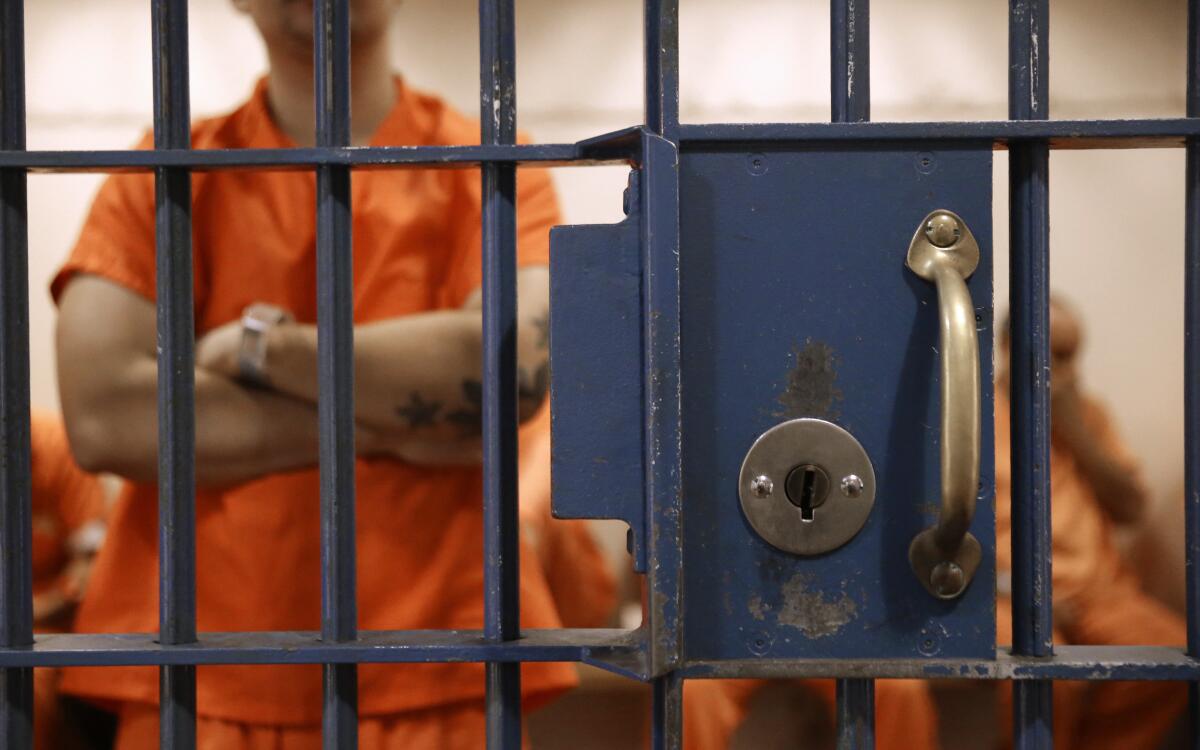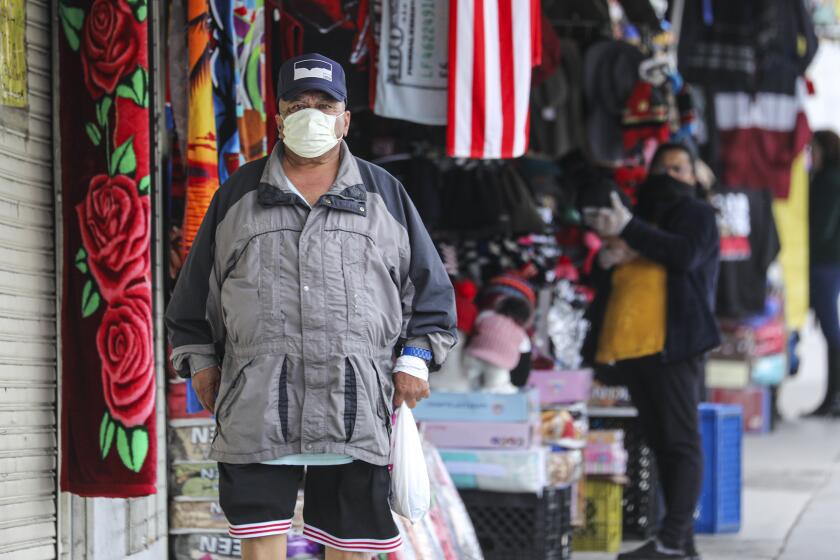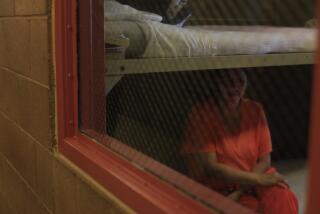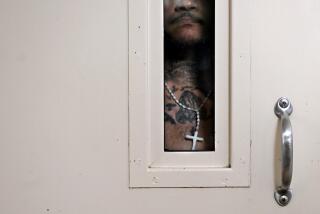Coronavirus plan for California prisons raises inmate and advocate concerns

SACRAMENTO — California prison administrators preparing for the threat of coronavirus within the state’s sprawling lockup system are basing those plans off their existing protocol for inmate flu.
But they will not discuss details of what changes might be made to a virus protection plan that currently calls for placing lines of tape on the floor to create isolation zones, and warns that ill individuals might have to share toilets with those who are well.
The lack of information has inmate advocates and others worried.
“Given the volume of incarcerated people in America, the conditions under which they are detained, and the current spread of the COVID-19 coronavirus, there is every reason to question whether American detention facilities, as a whole, are up to this challenge,” National Assn. of Criminal Defense Lawyers President Nina J. Ginsberg said in a statement released Wednesday.
The organization called for disclosure of steps to protect not only inmates and staff, “but also as concerns their loved ones, their communities and the communities in which these facilities are located. People are concerned, and there is absolutely no substitute for full transparency.”
California’s prison system has struggled for decades to provide minimum medical care, contending not just with overcrowding, but also with a shortage of doctors and antiquated facilities. So many preventable inmate deaths occurred that the system was put under control of a court-appointed receiver in 2006.
Get the latest coronavirus updates from our staff in California and around the world.
To date, the state has regained control over medical care in only 19 of its 35 prisons. They currently house 114,000 inmates, some double-bunked in cells built for one.
Some 4,300 more inmates are in private prisons or programs where medical protocols are even harder to access. An additional 3,000 prisoners are in camps across the state while helping to fight wildfires, meaning that virus quarantines could affect California’s fire response.
The challenges that a highly contagious, very deadly airborne virus presents in those conditions are underscored by past outbreaks: Legionnaires’ disease persisted all through 2019 in the water supply system of the state’s new medical prison in Stockton, and four other prisons this winter have been hit with outbreaks of mumps, also caused by a virus.
“My own lay opinion is … there’s no way to stop it in a prison, which is why Japan is closing its schools for a month,” said Don Specter, executive director of the Prison Law Office, one of the parties in long-running federal litigation over conditions within California’s prison system.
Specter said that state corrections officials had briefed him on plans for handling COVID-19 behind bars and they largely centered on existing protocols for the flu.
“Prisons throw people into the paths of epidemics, whether it is TB or HIV or the corona virus,” said Gregg Gonsalves, a Yale School of Public Health epidemiologist, in a call arranged by the American Civil Liberties Union.
“People without proper ventilation, it is a perfect breeding ground for quick transmission of any respiratory virus.”
His concerns extend beyond California.
“Prison healthcare isn’t what it should be…. The question is whether the U.S., state and local correctional facilities are up to the task of preventing infections and whether they have necessary resources to care for the sick, and I’m not sure they are up to the task.”
After several days of questions, the media office for the state prison system and the federal receiver on Monday released only a brief statement. They noted that there are no current plans to limit inmate visitation and that prison officials were “building on the robust influenza infection control guidelines already implemented at each institution.”
Requests by The Times for those prison-specific plans, made under the California Public Records Act, received no response. Nor did the California Department of Corrections and Rehabilitation provide a response to questions about why the documents are not being released.
On Wednesday, prison officials repeated statements made Monday, reiterated that there are no known cases of COVID-19 within the prison system and said the agency will “maintain open lines of communication with our law enforcement partners.”
The union that represents prison guards, the California Correctional Peace Officers Assn., did not respond to requests for information.
State officials did not respond when asked whether the corrections department believes it can prevent the widespread circulation of COVID-19 if it enters a state prison population.
The prison administration and federal receiver also declined to answer questions about whether incoming inmates are being screened for exposure to the virus — a practice already in place in some jails — or about how well-prepared the prison medical system is to isolate and treat severely ill infected inmates. Questions about supplies of ventilators and masks were also not answered.
The department’s flu plan illustrates many of the hurdles to containing an airborne virus. It notes that quarantined inmates can still eat meals and visit exercise yards where other inmates are present. “Tape can be placed on the floor to mark the isolation section with a second line of tape 3-6 feet away to mark the well-patient section,” the plan reads.
It further states that “special air handling or ventilation is not required.”
And it notes isolation areas should have bathrooms set aside exclusively for symptomatic patients, “if possible.”
“If there is no separate bathroom available, symptomatic patients should wear a surgical facemask when outside the isolation room or area.”
Other correctional institutions were more open about their plans.
In Sonoma County, which has declared a local public health emergency, jail officials are screening all incoming inmates, asking about any fevers, past travel to areas where the virus is present, and other possible exposure. Sgt. Juan Valencia said any indication that an inmate has been exposed to the virus will trigger a swift response.
“They’ll be taken by ambulance to the hospital,” Valencia said.
Sheriff’s deputies and jail staff meanwhile are reminded to wash their hands frequently, and make use of the hand sanitizer already provided as part of routine hygiene.
Other health experts also raised concerns about the role prisons can play in spreading the virus back into communities.
“We’ve talked to our local law enforcement agencies about this already, and getting them to think about who they are arresting and why,” said Scott Burris, director of Temple Law School’s Center for Public Health Law Research.
“Does it make sense to take somebody who may have been exposed to the virus and put them in the jail population where they are going to be spreading this potentially to other people and three weeks later set them free?
“And that’s just part of it. What about trials? How are we going to maintain those kind of activities? Or maybe we need to let that rest for a while?”
Behind judge’s chambers at the Sacramento County jail, a clerk on Tuesday was handling motions in preparation for hearings in the case of an accused serial killer, Joseph DeAngelo. The preliminary hearing in May is scheduled to last eight weeks, involving as many as 150 witnesses for the prosecution, and the hearings are typically jammed with elderly victims, out-of-town media and local spectators.
The clerk said there were no special plans in place for courtroom sanitation, beyond a worker who was walking the halls, wiping banisters with disinfectant. She pulled out her bottle of hand sanitizer and a tub of disinfectant wipes.
“This is what we’re doing,” she said.
More to Read
Sign up for Essential California
The most important California stories and recommendations in your inbox every morning.
You may occasionally receive promotional content from the Los Angeles Times.













